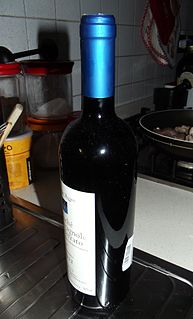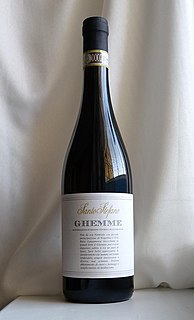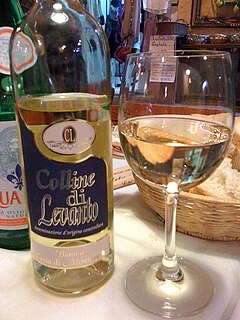
The Muscat family of grapes includes over 200 grape varieties belonging to the Vitis vinifera species that have been used in wine production and as raisin and table grapes around the globe for many centuries. Their colors range from white, to yellow, to pink to near black. Muscat grapes and wines almost always have a pronounced sweet floral aroma. The breadth and number of varieties of Muscat suggest that it is perhaps the oldest domesticated grape variety, and there are theories that most families within the Vitis vinifera grape variety are descended from the Muscat variety.

Costigliole d'Asti is a small Italian town in the Province of Asti, southern Piedmont. It lies about 13 kilometres south of the city of Asti in the Alto Monferrato, on the edge of the Langhe, in the alluvial plain of the river Tanaro southwards into the hills. The name derives from the Latin Corte Costeliolae.
Sauvignon vert is a white wine grape of the species Vitis vinifera prevalent in the Italian region of Friuli. It is widely planted in Chile where it was historically mistaken for Sauvignon blanc. The grape is distinct from the California planting of Muscadelle which is also called Sauvignon vert.

Ruché is a red Italian wine grape variety from the Piedmont region. It is largely used in making Ruché di Castagnole Monferrato, a small production red varietal wine which was granted Denominazione di Origine Controllata (DOC) status by presidential decree on October 22, 1987, and was granted the more prestigious Denominazione di Origine Controllata e Garantita (DOCG) status in 2010. The current DOC recognized area of production for the wine covers only about 100 acres of vines around the villages of Castagnole Monferrato, Refrancore, Grana, Montemagno, Viarigi, Scurzolengo and Portacomaro. Ruché di Castagnole Monferrato is, therefore, one of the lowest production varietal wines in Italy. The grape is also grown to some extent in the neighboring province of Alessandria.

Straw wine, or raisin wine, is a wine made from grapes that have been dried to concentrate their juice. The result is similar to that of the ice wine process, but is a much older process and suitable for warm climates. The technique dates back to pre-Classical times with wines becoming fashionable in Roman times and in late Medieval/Renaissance Europe when wines such as Malmsey and Candia were highly sought after. Traditionally, most production of these wines has been in Greece, the islands off Sicily, Cyprus, Northern Italy and the French Alps. However producers in other areas are now using with the method too.

Bardolino and Bardolino Superiore are Italian red wines produced along the chain of morainic hills in the province of Verona to the east of Lake Garda. Bardolino takes its name from the town Bardolino on the shores of Lake Garda and was awarded Denominazione di origine controllata (DOC) status in 1968. The Superiore is a stronger aged wine, and was promoted to Denominazione di origine controllata e garantita (DOCG) status in 2001. The blend of grapes used to produce the wine primarily includes Corvina, Rondinella, and Molinara. Up to 15% of the blend is allowed to include Rossignola, Barbera, Sangiovese, or Garganega, in any combination.
Cortese is a white Italian wine grape variety predominantly grown in the southeastern regions of Piedmont in the provinces of Alessandria and Asti. It is the primary grape of the Denominazione di origine controllata (DOC) wines of Cortese dell'Alto Monferrato and Colli Tortonesi as well as the Denominazione di Origine Controllata e Garantita (DOCG) wine of Cortese di Gavi. Significant plantings of Cortese can also be found in the Lombardy region of Oltrepò Pavese and in the DOC white blends of the Veneto wine region of Bianco di Custoza. Cortese has a long history in Italian viticulture with written documentation naming the grape among the plantings in a Piedmontese vineyard as early as 1659. The grape's moderate acidity and light flavors has made it a favorite for the restaurants in nearby Genoa as a wine pairing with the local seafood caught off the Ligurian coast.

Tuscan wine is Italian wine from the Tuscany region. Located in central Italy along the Tyrrhenian coast, Tuscany is home to some of the world's most notable wine regions. Chianti, Brunello di Montalcino and Vino Nobile di Montepulciano are primarily made with Sangiovese grape whereas the Vernaccia grape is the basis of the white Vernaccia di San Gimignano. Tuscany is also known for the dessert wine Vin Santo, made from a variety of the region's grapes. Tuscany has forty-one Denominazioni di origine controllata (DOC) and eleven Denominazioni di Origine Controllata e Garantita (DOCG). In the 1970s a new class of wines known in the trade as "Super Tuscans" emerged. These wines were made outside DOC/DOCG regulations but were considered of high quality and commanded high prices. Many of these wines became cult wines. In the reformation of the Italian classification system many of the original Super Tuscans now qualify as DOC or DOCG wines but some producers still prefer the declassified rankings or to use the Indicazione Geografica Tipica (IGT) classification of Toscana. Tuscany has six sub-categories of IGT wines today.
Greco is an Italian wine grape that may be of Greek origin. The name relates to both white (Greco bianco) and black (Greco nero) grape varieties. While there is more land area dedicated to Greco nero, the Greco bianco is the grape most commonly referred to by "Greco". In the Campania region it is used to produce the Denominazione di Origine Controllata e Garantita (DOCG) wine Greco di Tufo. In Calabria, it is used to make the Denominazione di Origine Controllata (DOC) wine Greco di Bianco. The name "Greco" is sometimes used as a synonym for several varieties of supposed Greek origins-most notably Trebbiano.

Friuli-Venezia Giulia wine is wine made in the northeastern Italian region of Friuli-Venezia Giulia. Once part of the Venetian Republic and with sections under the influence of the Austro-Hungarian Empire for some time, the wines of the region have noticeable Slavic and Germanic influences. There are 11 Denominazione di origine controllata (DOC) and 3 Denominazione di Origine Controllata e Garantita (DOCG) in the Friuli-Venezia Giulia area. The region has 3 Indicazione Geografica Tipica (IGT) designations Alto Livenza, delle Venezie and Venezia Giulia. Nearly 62% of the wine produced in the region falls under a DOC designation. The area is known predominantly for its white wines which are considered some of the best examples of Italian wine in that style. Along with the Veneto and Trentino-Alto Adige/Südtirol, the Friuli-Venezia Giulia forms the Tre Venezie wine region which ranks with Tuscany and Piedmont as Italy's world class wine regions.
Verduzzo is a white Italian wine grape grown predominantly in the Friuli-Venezia Giulia region of northeast Italy. It is also found in significant plantings in the Piave Denominazione di origine controllata (DOC) of the Veneto region, though some of these plantings may be of the separate Verduzzo Trevigiano variety. Verduzzo Friulano is used in varietal and blended wines, many of which fall under DOC as well as vino da tavola designations, that range in style from dry to late harvest wines. According to wine expert Oz Clarke, most of the sweeter examples of Verduzzo can be found in the Friuli-Venezia Giulia with the grape being used for progressively drier styles of the wine the further west into the Veneto.

Moscato Giallo or Yellow Muscat is a white Italian wine grape variety that is a member of the Muscat family of grapes. Known for its large deep cluster of loose, deep-yellow berries and golden colored wine, Moscato Giallo is grown mostly in northern Italy where it is most often used to produce passito style dessert wines. The grape is also planted in Croatia where it is known as Muškat žuti.
The Colli Orientali del Friuli is a Denominazione di origine controllata (DOC) located in the Italian wine region of Friuli-Venezia Giulia. The region is located in the province of Udine and is sub-divided into three main sections; Ramandolo in the north, Cialla and Corno di Rosazzo. The climate and soil is very similar to the neighboring DOC of Collio Goriziano and the two region share many winemaking similarities as well. The main distinction between the Colli Orientali del Friuli and Collio Goriziano lie in the increased red and dessert wine production of the Colli Orientali del Friuli. The region also includes within its boundaries the three Denominazione di Origine Controllata e Garantita (DOCG) of the Friuli-Venezia Giulia Ramandolo and the two passito wine DOCGs of Colli Orientali del Friuli Picolit and Colli Orientali del Friuli Picolit-Cialla.

Grechetto or Grechetto bianco is a white Italian wine grape variety of Greek origins. The grape is planted throughout central Italy, particularly in the Umbria region where it is used in the Denominazione di origine controllata (DOC) wine Orvieto and Denominazione di origine controllata (DOC) wine Valdichiana Toscana. It is primarily a blending grape, though some varietal wine is also produced. Grechetto is commonly blended with Chardonnay, Malvasia, Trebbiano and Verdello. The grape's thick skin provides good resistance to downy mildew which can attack the grape late in the harvest season. This makes Grechetto a suitable blending grape in the production of Vin Santo.

Ghemme is a red Italian wine with Denominazione di Origine Controllata e Garantita status produced in the Colli Novaresi viticultural area in the hills of the Province of Novara in Piedmont. It was awarded DOC status in 1969 and received its DOCG classification in 1997.

Liguria is an Italian wine region located in the northwest region of Italy along the Italian Riviera. It is bordered by the Piedmont wine region to the north, the Alps and French wine region of Provence to the west, the Apennine Mountains and the Emilia-Romagna wine region to the east with a small border shared with Tuscany in the south-east along the Ligurian sea.

Pecorino is a white Italian wine grape variety that grows in the Marche, Abruzzo, Tuscany, Umbria and Lazio regions of Italy. Ampelographers believe that the grape is likely native to Marche, where the soil destined for this cultivation increases every year. This grape variety is used to produce the DOCG wines, like the Offida Pecorino DOCG, and the DOC wines, like the Falerio dei Colli Ascolani, the Colli Maceratesi and the Falerio dei Colli Ascolani.

Mastroberardino is an Italian winery located in Atripalda, in Provincia di Avellino, in the Campania region. Founded in 1878, the winery is known for its production of Taurasi DOCG as well as its ampelography work in identifying and preserving ancient grape varieties like Greco and Fiano. The work of the Mastroberardino family, particularly Antonio Mastroberardino, in this field is widely respected and Antonio is often called "The Grape Archaeologist".
Barbera bianca is a white Italian wine grape variety that is grown in the Piedmont wine region of northwest Italy. Despite being named Barbera bianca, the grape is not a color mutation of the red Piedmontese wine grape Barbera that is the third most widely planted grape variety in Italy. In fact, DNA analysis conducted in the early 21st century shows no genetic relationship at all between the two grape varieties.
















